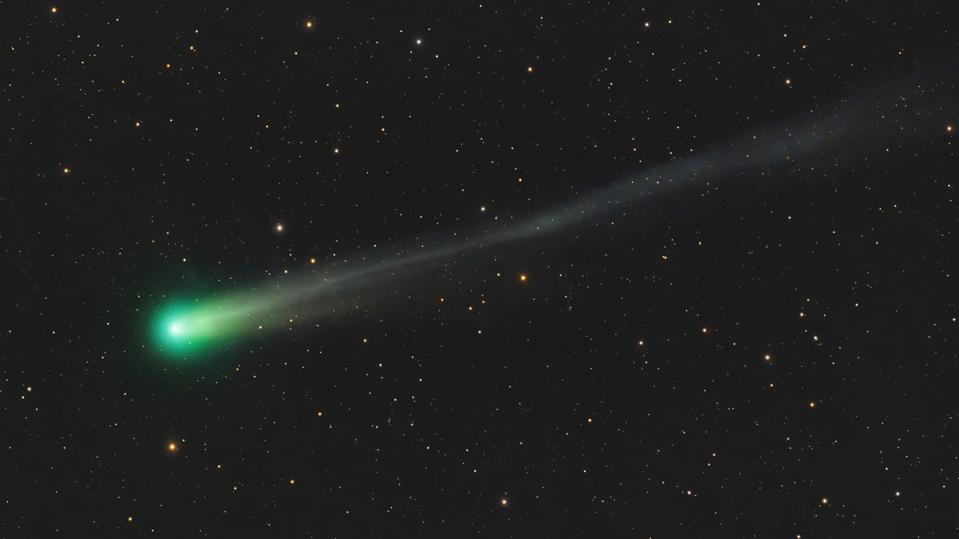Topline
Here’s a final call for anyone who wants to see two green comets before they race away from Earth and get too dim to see. On Monday, Oct. 27, 2025, Comet Lemmon (C/2025 A6) and Comet SWAN (C/2025 R2) are still visible in binoculars about 90 minutes after sunset, in the northwest and south, respectively. However, as well as fading, a 33%-lit waxing crescent moon will very soon make comet-watching more challenging.
Key Facts
Comet Lemmon can be found west of the Big Dipper, beyond bright star Arcturus, while Comet SWAN is moving towards Saturn, and is presently beneath Altair, the bright star at the tip of the famous Summer Triangle. The best time to look is 90 minutes after sunset.
If you want the best view, use 8×42 or 10×50 binoculars from a Dark Sky Place or somewhere that appears dark on a light pollution map.
Use stargazing apps such as Sky Guide, Stellarium and SkySafari to find the comets, or finder charts at In-The-Sky.com.
Comet Lemmon was discovered on Jan. 3, 2025, by the Mount Lemmon Survey near Tucson, Arizona, and will reach its closest point to the Sun on Nov. 8. It will return to the inner solar system in about 1,150 years.
Comet SWAN was found on Sept. 11, 2025, as it looped around the sun. Lemmon last visited the inner solar system in AD 875 and will return around 3175, while SWAN takes roughly 20,000 years to complete one orbit.
When And Where To See The Comets
The best time to spot Comet Lemmon and Comet SWAN on Monday, Oct. 27, is during a 30-minute window starting about 90 minutes after sunset where you are. Both are visible after sunset but in opposite parts of the sky — Lemmon in the northwest, SWAN in the southwest. For New York City, where sunset is at 5:54 p.m. EDT, the ideal time for evening viewing is 7:24-7:54 p.m. EDT.
How To Find Comet Lemmon
Distance from the Sun: 55.9 million miles (90.0 million kilometers)
Distance from Earth: 61.5 million miles (99.0 million kilometers)
After sunset on Monday, Oct. 27, look for Comet Lemmon due west, above-left of bright star Arcturus, low on the west-northwest horizon. Trace the stars in the Big Dipper’s curved handle and go in an “arc to Arcturus.” Now go in a right angle to the next bright star, Rasalhague, the brightest in the vast constellation Ophiuchus. Comet Lemmon will be directly below the bright star Vega, high above. Its height above the horizon varies by location, but from New York, the comet will appear about 21 degrees up at 7:24 p.m. EDT and will gradually sink as twilight deepens.
How To Find Comet Swan
Distance from the sun: 102.8 million miles (165.5 million kilometers)
Distance from Earth: 28.9 million miles (46.5 million kilometers)
Comet SWAN will be visible in binoculars on Monday, Oct. 27, low in the south after sunset. SWAN will be in the constellation Aquarius, below and to the left of the bright star Altair in the Summer Triangle. You’ll find it between Altair and Fomalhaut, a bright star closer to the horizon. The comet’s height above the horizon will vary depending on your location, but from New York, it will be around 45 degrees up as it becomes visible.
3i/atlas: The Interstellar Visitor
In July 2025, astronomers found 3I/ATLAS, the third interstellar object ever found — and the first bright enough for detailed study. Unlike Lemmon and SWAN, which hail from the Oort Cloud, 3I/ATLAS comes from another star system. With a coma and tail clearly visible, it’s giving astronomers a rare chance to compare a foreign comet with a local one in the same year. While almost all comets loop around the sun, 3I/ATLAS has broken free of its star and is traveling at 30,000 miles (209,000 kilometers) per hour through the solar system.
Check my feed every day this month for a daily “comet tracker” with finder charts and tips for viewing Comet Lemmon and Comet SWAN from mid-northern latitudes. Also read How To Photograph The Green Comets, Best Stargazing Apps For Finding The Comets and 25 Dark Sky Parks In The U.S. To See The Comets.

